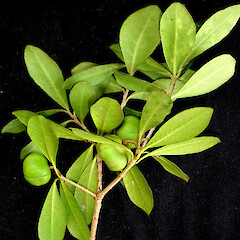Pittosporum fairchildii
Common name
Fairchild’s kōhūhū
Synonyms
None
Family
Pittosporaceae
Flora category
Vascular – Native
Endemic taxon
Yes
Endemic genus
No
Endemic family
No
Structural class
Trees & Shrubs - Dicotyledons
NVS code
The National Vegetation Survey (NVS) Databank is a physical archive and electronic databank containing records of over 94,000 vegetation survey plots - including data from over 19,000 permanent plots. NVS maintains a standard set of species code abbreviations that correspond to standard scientific plant names from the Ngä Tipu o Aotearoa - New Zealand Plants database.
PITFAI
Chromosome number
2n = 24
Current conservation status
The conservation status of all known New Zealand vascular plant taxa at the rank of species and below were reassessed in 2017 using the New Zealand Threat Classification System (NZTCS) – more information about this can be found on the NZTCS website. This report includes a statistical summary and brief notes on changes since 2012 and replaces all previous NZTCS lists for vascular plants.
Please note, threat classifications are often suggested by authors when publications fall between NZTCS assessment periods – an interim threat classification status has not been assessed by the NZTCS panel.
- Conservation status of New Zealand indigenous vascular plants, 2017 . 2018. Peter J. de Lange, Jeremy R. Rolfe, John W. Barkla, Shannel P. Courtney, Paul D. Champion, Leon R. Perrie, Sarah M. Beadel, Kerry A. Ford, Ilse Breitwieser, Ines Schönberger, Rowan Hindmarsh-Walls, Peter B. Heenan and Kate Ladley. Department of Conservation. Source: NZTCS and licensed by DOC for reuse under the Creative Commons Attribution 4.0 International licence.
2017 | At Risk – Naturally Uncommon | Qualifiers: CD, IE
Previous conservation statuses
2012 | At Risk – Naturally Uncommon | Qualifiers: CD, IE
2009 | At Risk – Naturally Uncommon | Qualifiers: IE
2004 | Range Restricted
Brief description
Large shrub bearing dark green leathery leaves that are paler underneath and with large yellow-green capsules inhabiting the Three Kings Islands. Leaves 5-7.5cm long, sparsely covered in white fuzz when young. Fruit 2.5cm wide, splitting into three or four sections to show the dark sticky seeds.
Distribution
Endemic. New Zealand: Three Kings Islands where it is known from North East, Great (Manawa Tawhi), South East and West islands.
Habitat
Coastal forest and sheltered cliff faces. Usually found in the forest understorey, though on occasion it may grow within open petrel scrub.
Detailed description
Gynodioecious shrub to small tree 3-6 m tall. Trunk stout, sometimes with 2 or more arising from ground grey-black, lenticillate. Branches erect to spreading, grey-black; branchlets similar clad in grey to brownish-grey tomentum, emergent shoots and immature branchlets white-tomentose, all soon becoming glabrous. Leaves alternate, usually crowded toward branch and branchlet apices. Petioles 3-8 x 0.5-2 mm, white to brown-tomentose. 40-70 x 20-38 mm, dark to light green above, much paler beneath, obovate, elliptic-obovate, elliptic-oblong or oblanceolate, apex obtuse or acute, base acute, margins entire; surfaces white to brown-tomentose when young, soon glabrous above but remaining finely tomentulose below when mature; very coriaceous, sometimes revolute. Flowers in terminal 2-4-flowered fascicles; pedicels 12-20 mm, accrescent in fruit, brown-tomentose, subtended by a whorl of leaves and caducous, ciliate, 5-10 mm long, bud scales. Sepals 4-7 x 2-3.5 mm, lanceolate, acute, brown-tomentose outside, glabrous within, ciliate. Petals 9-14 x 2.5-4.5 mm, lanceolate-oblong, subacute, free, spreading from about half their length, purple, chocolate or white. Stamens 7-8.5 mm, anthers 1.5-2.5 x 0.5-1.3 mm, sagittiform or elliptic-oblong. Ovary 2.5-6 x 2-4 mm, brown-tomentose; style 3-4 mm, stigma capitate or truncate. Capsules 20-25 mm diameter, 3-valved, subglobose, finely brown tomentose, glabrate, smooth to finely rugose; valves green maturing pale yellow, coriaceous to almost fleshy, scarcely opening at maturity. Mucilage bright yellow. Seeds 20-30, black, round.
Similar taxa
Superficially similar to Pittosporum crassifolium but differing by its glabrate mature leaves and capsules, and mainly brownish rather than grey-white tomentum. The glabrate, mature capsules of P. fairchildii scarcely open, and are coloured green or yellow-green, while those of P. crassifolium are copiously covered in white-grey indumentum, and fully open when mature.
Flowering
May - September
Flower colours
Brown, Violet/Purple
Fruiting
August - June (may be present throughout the year)
Propagation technique
Easy from fresh seed which germinates within 6-8 months from sowing. Semi-hardwood cuttings also strike readily. This species readily hybridises with P. crassifolium Banks et Sol. ex A.Cunn., so should be planted well away from that species if pure seed is desired. Some nursery lines sold as P. fairchildii are in fact this hybrid.
Threats
Not threatened. However, it occupies a rather small geographic area and so qualifies for Range Restricted status.
Etymology
pittosporum: Pitch seed
Where To Buy
Not commercially available.
Attribution
Fact sheet prepared for NZPCN by P.J. de Lange 30 August 2006. Description adapted from Cooper (1956).
References and further reading
Cooper, R.C. 1956: The Australian and New Zealand species of Pittosporum. Annals of the Missouri Botanical Garden 43: 87-188
NZPCN Fact Sheet citation
Please cite as: de Lange, P.J. (Year at time of access): Pittosporum fairchildii Fact Sheet (content continuously updated). New Zealand Plant Conservation Network. https://www.nzpcn.org.nz/flora/species/pittosporum-fairchildii/ (Date website was queried)










